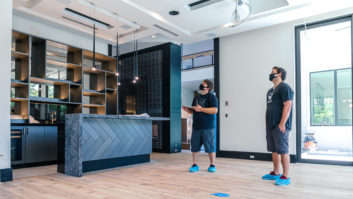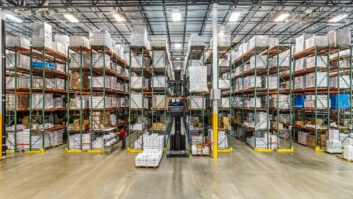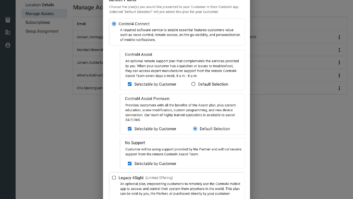The year was 1989. The B-52s and Duran Duran topped the charts. Driving Miss Daisy took the Oscar for Best Picture, and a new organization called CEDIA was hatched.
In Irvine, California, Bill Anderson’s office at Genesis Audio-Video was just making the transition to computers after years of pounding out custom installation bids by typewriter.
In Jacksonville, Florida, Behrens Audio Video president Bill Behrens was working on a very large custom installation built around AudioAccess equipment, when he got the call from AudioAccess president Chris Stevens, summoning him to Las Vegas for a meeting about an idea for a “new organization.”
A most unlikely snowfall hit the ground in Charleston, South Carolina, that year, following on the destructive heels of Hurricane Hugo during which Audio Warehouse’s Russ Pritchard read his insurance policy by flashlight, wondering how he would even make payroll.
“We were a founding member of CEDIA, but, ironically, that first year was the closest we’ve ever come to going out of business due to the hurricane,” he recalled. “We had employees sleeping in the store. No one had power, but we were able to bring in D cell batteries and Bentley B&W portable TVs to sell, and we ran the front of the store on generators.”

Pritchard vividly remembers a meeting in the backroom of a restaurant during a summer CES in Chicago before CEDIA was launched. “A bunch of dealers who were interested in starting a custom group gathered,” he said. “The hot debate that day that resonated with me was about separating retail and custom sales people.”
Anderson also had caught wind of an early meeting to discuss forming the organization. “It was in Vegas, and we had already been engrossed in custom installation for eight years,” he said. “I thought this was exactly what our consumer electronics industry needed, a new voice.”
HOW IT ALL BEGAN
The original idea behind CEDIA, as Anderson remembers it, was to try to get manufacturers to recognize that there was another channel to bring goods into customers’ homes. “We spent a fair amount of time and voted formally, agreeing to go forward and coming up with the CEDIA name,” he recalled.
When Anderson later joined the CEDIA board, eventually migrating up to the executive committee, he chaired the membership committee and PR task force, making it a priority to personally sign all membership applications.

“I would phone each new member and welcome them, following up with a letter to make sure they felt the importance of contributing through their membership to the organization,” he said. “I came to the realization that to become stronger, growth was necessary, and that the more we grew the more we’d become a serious force in the industry.”
That initial EXPO was not the polished event of today, according to Jill Kent, a founding CEDIA member and president of Electronic Interiors Inc., in Greenwich, Connecticut. “There were, at most, 100 people, and we served potato chips and pretzels as the main course,” she said. “I was the first woman on the board and the first female EXPO chair; it was kind of a gentlemen’s club, but we were passionate in a naïve sort of way. We thought we would change the world.”
What made a difference as CEDIA developed was allowing electricians and security systems companies in, Kent said. “In the beginning, we were a purist organization, and we didn’t even want sales reps. But, we needed different groups of knowledge and, in a way, CEDIA has become more sophisticated because of it.”
RETAILERS VS. INSTALLERS
Bjorn Dybdahl was the token retailer on the first CEDIA board. “That’s how I played it,” he recalled. “The installation group had a fear of retailers. It took time, but most of that fear went away.”

Russ Pritchard’s Charleston, South Carolina, Audio Warehouse store barely survived two freak storms in 1989, and he vividly remembers a meeting in the backroom of a restaurant during a summer CES in Chicago before CEDIA was launched. Above, right, Pritchard in 2004.
Now Bjorn’s Audio Video, in San Antonio, Texas is still an independent retailer doing custom installation. “We’re a hybrid now,” he said. “Back then we had been doing installations for a long time, but it took us a number of years to get serious about it and to get organized.”
Dybdahl also served on the board for PARA (Professional Audio/Video Retailers Association). “I went back and forth between the two boards, and I told the CEDIA board that I couldn’t put in a tremendous amount of time. PARA was aimed at retailers, and custom was not the rule there. CEDIA looked at how to make the installation business better and how to improve technically. It was how-to.”
Picking up the phone to network is easy in the CEDIA channel, Dybdahl added. “CEDIA is a place to come and learn from other people or even to ‘steal.’ I find that I learn so much from others. That’s the main thing. My role is different now as I am on the new CEDIA advisory board, and through the advisory board I look forward to reconnecting with friends and acquaintances from my early days in CEDIA.”
Behrens AV had been doing custom- installed systems since the late ’70s, which was 10 years prior to the formation of CEDIA and long before it was cool. “At the time, it was a niche business catering mainly to hobbyists and a few eccentric wealthy clients,” Bill Behrens recalled.
Products designed specifically for custom installation applications were just beginning to arrive on the scene in the mid to late ’80s.
“I don’t think any of us had any idea back then just how big CEDIA would become,” he added. “Most of us thought that it would be similar to a smaller version of PARA, a closeknit group of custom installation dealers sharing knowledge and resources.”
But the industry evolved and matured, and CEDIA grew by leaps and bounds. “That AudioAccess installation we were working on back in 1989 ended up as the cover feature of the fourth issue of Audio-Video Interiors magazine. Now, 20 years down the road, we have removed, redesigned, and reinstalled that same system four times, and CEDIA has grown to about 3,000 members.”
COMMUNICATION IS THE KEY
Murray Kunis, founder/president of Future Home, in Los Angeles, has a February 1990 Time magazine in which a story begs the question, “Who Wants to Wait for HDTV?” Even that far back he was tracking the next big technology.
“For consumers building what were then top-of-the-line $25,000 home theaters, this new thing called an AV receiver was the heart of the system,” he recalled. “At the time, major name-brand manufacturers had no idea this market existed.”
Kunis said that although CEDIA has not proactively permeated the public consciousness like AIA or ASID has in Los Angeles, the association has succeeded in facilitating communication between installers and manufacturers. “The issue was that manufacturers were disconnected from the custom market,” he remembered. “I would contact Mitsubishi with price as no object, but I needed only eight products a year. Because of CEDIA, 500 guys need eight a year and this consumer did not go into retail stores. Here was the pathway for the communication chain, so products could be developed. Within a relatively short time the whole custom market and repetitive custom approach was created, due to CEDIA.”
Eric Bodley, the new VP and general manager of consumer electronics for connector manufacturer, PPC, also was actively involved in CEDIA as early as 1989. After joining the board two years later, Bodley was CEDIA president from 1993 to 1994.
“I was working at Sound Advice when CEDIA first formed, and I saw the people involved in the organization as having a passion for custom installation,” he said. “After I left Sound Advice and started Bodley & Associates, I began getting calls from Bjorn [Dybdahl] and others asking for advice on how to make the retail to custom transition. So, I developed a comprehensive training program on how to sell custom installation at retail. One of my biggest clients at that time was Monster Cable, and I worked with them for a number of years.”

Since the early years of just tabletop exhibits, CEDIA EXPO has evolved to a fully-formed trade show.
Bodley is gratified to see recognition for those who have been involved with CEDIA for so long. “The board has term limits, and once you’d finished your bit for God, country, and CEDIA, it was rare to be tapped as a resource. I’ve been proactive about staying involved. I’ve never lost the passion, and I’m on the CEDIA manufacturer’s team to make sure our events remain relevant to manufacturers. He also is on the instructor pool action team focusing on those who teach at events.
It’s easy to forget, he added, that CEDIA is a subset of the consumer electronics industry. “We’re part of the big picture of consumer electronics, and CEDIA has been an excellent ambassador for their channel, staying relevant within a large, varying industry. It’s helped me to maintain my focus on our corner of the business.”
ALWAYS ENTERTAINING
One fundamental that hasn’t changed over the years is that the CEDIA channel provides people with a delivery mechanism for entertainment content. Michael Hattem, president of Brentwood Communications in Los Angeles, remembers when, pre- CEDIA, people just wanted to listen to a phonograph record or tape, or to watch TV. “Fast forward to today, and it’s iPods, Blu-ray players, and high-definition. At the end of the day, consumers are still buying and enjoying that music or movie, and we are far more sophisticated in the different ways we hook the equipment up and they operate it,��� he said.
The core principle—simple to watch and operate— remains, he added. “I ask my customers to name the one technology that is more than a hundred years old and that most people can operate fairly easily with no instruction, and that answer is ‘drive a car.’ If we make our control systems or entertainment systems operate with that in mind, people will use the products rather than let them sit and collect dust.”
Hattem, who also attended the 1989 CEDIA meeting in Chicago, foresees custom installation as becoming more mainstream, so that more electricians will do what CEDIA members do. “Systems integration comes from experience, and CEDIA’S education is what will continue to strengthen our industry and keep us one step ahead,” he said. “In the future, CEDIA will expand and have different divisions and more levels of certification. What started out from humble beginnings will be a mega machine.”

Bill Skaer (middle, with Andy Wilcox, left, and Steve Hayes) and his business partner Eric Grundelman were one of first non-retailer firms to buy direct.
Like other CEDIA members, Hattem fondly recalls CEDIA parties, particularly the legendary Texas barbeques at the Dallas home of Bill Skaer, president/CEO, Eric Grundelman, and 2006 CEDIA Lifetime Achievement Award winner.
Skaer and business partner Eric Grundelman were one of first non-retailer firms to buy factory direct. “Those of us in pure custom had no way to let them know we were legit,” he said. “Guys like us who were persistent laid the groundwork, but we were scattered across the country and had no power. As time went by, manufacturers understood we had an outrageous partnership opportunity to offer. We’re in the homes with equipment, unlike a box store.”
CEDIA, Skaer added, forced most manufacturers to look at custom integrators as a group. And although volunteers have led most initiatives over the years, the bulk of the CEDIA membership, he said, is still unaware of the amount of involvement of fulltime CEDIA office staff. “They’re out there keeping up on every piece of legislation in the country affecting our business,” Skaer noted. “We’ve been able to pull together and appear on steps of statehouses everywhere.
THE EXPO RULES
Former CEDIA president Mitchell Klein (now Universal Remote Control’s director of business development) recalls the days when CEDIA was the new and small kid on the block, compared to CES and InfoComm.
“I used to attend InfoComm to see what hot tech was out there that would apply to our hybrid business,” he said. “I found more interesting things that we could manipulate into our systems. Now CEDIA is a true challenger, and you go to CEDIA EXPO to find the hot new tech that trickles into the commercial world. It’s flipped upside down, not to take away from the other shows, but you don’t need them to find new technologies anymore.”
Russ Pritchard agreed. “The best lesson I’ve learned from CEDIA is to never think you know everything; each year I leave EXPO with new ideas about business processes, technology changes, and solutions, not to mention meeting new friends. I’ve learned that while we think we are the only ones that have certain types of problems, by networking at shows, you discover they are often industry-wide problems. The collective knowledge of those who share in the solutions to our common problems is one of the most powerful tools CEDIA has to offer.”
Karen Mitchell is a freelance writer in Boulder, Colorado.







